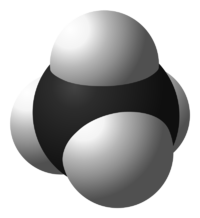Methane: Difference between revisions
J.williams (talk | contribs) m (1 revision imported) |
No edit summary |
||
| Line 1: | Line 1: | ||
[[Category:Done | [[Category:Done 2017-07-01]] | ||
[[File:800px-Methane-3D-space-filling.svg.png|thumb| | <translate> | ||
<!--T:1--> | |||
[[File:800px-Methane-3D-space-filling.svg.png|thumb|200px|Figure 1. Space filling model of methane; the white spheres represent [[hydrogen]] atoms and the black spheres represent [[carbon]] atoms.<ref> (2014, Dec. 12). ''Methane-3D-space-filling'' [Online]. Available: http://commons.wikimedia.org/wiki/File:Methane-3D-space-filling.svg#mediaviewer/File:Methane-3D-space-filling.svg</ref>]] | |||
<onlyinclude>'''Methane''' is a [[hydrocarbon]] | <!--T:2--> | ||
<onlyinclude>'''Methane''' is an [[alkane]] with the chemical formula CH<sub>4</sub>. As a [[hydrocarbon]], it can undergo [[hydrocarbon combustion]] which gives off [[heat]]. Methane is the main [[hydrocarbon]] component of [[natural gas]], which is a type of [[fossil fuel]].</onlyinclude><ref>“NATURAL GAS FAQs,” Pacific Northern Gas RSS. [Online]. Available: http://www.png.ca/natural-gas-faqs/. [Accessed: 24-May-2017]</ref> | |||
<!--T:3--> | |||
At typical [[temperature]]s and [[pressure]]s it is a [[gas]] and makes up around 95% of the content of [[liquefied natural gas]], and around 80-90% of [[natural gas]].<ref>(2014, Jun. 10). ''Composition of Natural Gas and LNG'' [Online]. Available: http://www.beg.utexas.edu/energyecon/lng/LNG_introduction_07.php</ref> Methane is also a [[greenhouse gas]], like [[carbon dioxide]] (CO<sub>2</sub>). It has a shorter [[atmospheric lifetime]] than CO<sub>2</sub>, at 12 years,<ref name=book1>(2014, Jun. 10). ''Direct Global Warming Potentials'' [Online]. Available: http://www.ipcc.ch/publications_and_data/ar4/wg1/en/ch2s2-10-2.html</ref> but this is "balanced" by the fact that it is more effective at trapping heat than CO<sub>2</sub>, as methane has a [[GWP]] ([[Global warming potential]]) of 21.<ref>''Direct Global Warming Potentials'' [Online]. Available: http://www.ipcc.ch/publications_and_data/ar4/wg1/en/ch2s2-10-2.html [Accessed: 24-May-2017.</ref> | |||
==Properties== | <!--T:4--> | ||
Methane [[combustion]] (see simulation at bottom of page) provides a significant fraction of the world's [[primary energy]], and is used for [[home heating]], cooking food, heating [[water]], and [[electrical generation]]. It can even provide energy for [[transportation]]. However, this means that it is also a significant contributor to [[climate change]] since this methane produces a fair amount of the [[carbon dioxide]] that humans emit into the [[atmosphere]]. | |||
==Properties== <!--T:5--> | |||
Below is a table of some of the basic properties of methane. | Below is a table of some of the basic properties of methane. | ||
{| class="wikitable" | {| class="wikitable" | ||
| Line 25: | Line 32: | ||
|} | |} | ||
==Combustion Animation== | ==Combustion Animation== <!--T:6--> | ||
Methane | |||
<!--T:7--> | |||
Methane releases its [[chemical energy]] by undergoing [[hydrocarbon combustion]]. Below is a [[hydrocarbon combustion]] animation showing the net reaction that occurs when methane combines with [[oxygen]]. | |||
<!--T:8--> | |||
<center>CH<sub>4</sub> + 2O<sub>2</sub> → CO<sub>2</sub> + 2H<sub>2</sub>O Heat Energy ([[Enthalpy]]) </center> | |||
<!--T:9--> | |||
<html><iframe src='http://energyeducation.ca/simulations/combustion/combustion_methane.html' width='900px' height='330px' style='border:none;position:relative;left:-35px'></iframe></html> | <html><iframe src='http://energyeducation.ca/simulations/combustion/combustion_methane.html' width='900px' height='330px' style='border:none;position:relative;left:-35px'></iframe></html> | ||
<!--T:10--> | |||
The [[hydrocarbon combustion]] reaction releases heat [[energy]] and is an example of an [[exothermic reaction]]. The reaction also has a negative [[enthalpy]] change (ΔH) value. | |||
==References== | ==References== | ||
{{reflist}} | {{reflist}} | ||
</translate> | |||
<languages /> | |||
[[Category:Uploaded]] | [[Category:Uploaded]] | ||
Revision as of 17:05, 14 July 2017
<translate>
Methane is an alkane with the chemical formula CH4. As a hydrocarbon, it can undergo hydrocarbon combustion which gives off heat. Methane is the main hydrocarbon component of natural gas, which is a type of fossil fuel.[2]
At typical temperatures and pressures it is a gas and makes up around 95% of the content of liquefied natural gas, and around 80-90% of natural gas.[3] Methane is also a greenhouse gas, like carbon dioxide (CO2). It has a shorter atmospheric lifetime than CO2, at 12 years,[4] but this is "balanced" by the fact that it is more effective at trapping heat than CO2, as methane has a GWP (Global warming potential) of 21.[5]
Methane combustion (see simulation at bottom of page) provides a significant fraction of the world's primary energy, and is used for home heating, cooking food, heating water, and electrical generation. It can even provide energy for transportation. However, this means that it is also a significant contributor to climate change since this methane produces a fair amount of the carbon dioxide that humans emit into the atmosphere.
Properties
Below is a table of some of the basic properties of methane.
| Chemical formula | CH4 |
| Molar mass | 16.04 grams/mole |
| Energy density[6] | 55.5 MJ/kg |
| Melting point | -183oC[7] |
| Boiling point | -164oC[7] |
| GWP | 21 |
| Atmospheric lifetime | 12 years |
Combustion Animation
Methane releases its chemical energy by undergoing hydrocarbon combustion. Below is a hydrocarbon combustion animation showing the net reaction that occurs when methane combines with oxygen.
The hydrocarbon combustion reaction releases heat energy and is an example of an exothermic reaction. The reaction also has a negative enthalpy change (ΔH) value.
References
- ↑ (2014, Dec. 12). Methane-3D-space-filling [Online]. Available: http://commons.wikimedia.org/wiki/File:Methane-3D-space-filling.svg#mediaviewer/File:Methane-3D-space-filling.svg
- ↑ “NATURAL GAS FAQs,” Pacific Northern Gas RSS. [Online]. Available: http://www.png.ca/natural-gas-faqs/. [Accessed: 24-May-2017]
- ↑ (2014, Jun. 10). Composition of Natural Gas and LNG [Online]. Available: http://www.beg.utexas.edu/energyecon/lng/LNG_introduction_07.php
- ↑ (2014, Jun. 10). Direct Global Warming Potentials [Online]. Available: http://www.ipcc.ch/publications_and_data/ar4/wg1/en/ch2s2-10-2.html
- ↑ Direct Global Warming Potentials [Online]. Available: http://www.ipcc.ch/publications_and_data/ar4/wg1/en/ch2s2-10-2.html [Accessed: 24-May-2017.
- ↑ (2014, Dec. 12). Chemical Potential Energy [Online]. Available: http://physics.info/energy-chemical/
- ↑ 7.0 7.1 (2015, Jan. 29). Boiling Points And Structures Of Hydrocarbons [Online]. Available: http://www.elmhurst.edu/~chm/vchembook/501hcboilingpts.html
</translate> <languages />


